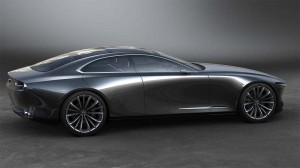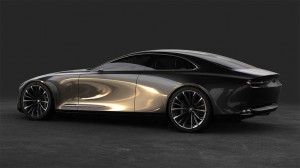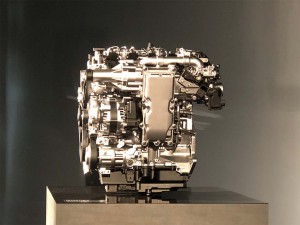
Mazda is finishing up a "Large Architecture," like the one that underpinned the 2017 Vision Coupe Concept.
For such a small company, Mazda has had a history of coming up with lots of creative powertrain technology, from its original rotaries to the latest Skyactiv-X that manages to combine some of the best attributes of a diesel and a gas engine. Now, it appears, the Hiroshima-based manufacturer is busy working on an inline-six design that could be powered both by gas and diesel.
Considering the size and design of Mazda’s current line-up, that might seem an odd choice, however. With the exception of the MX-5 Miata, the automaker’s products have been designed to use shorter powertrains that work in a transverse, or east-west, configuration, rather than the longitudinal, or north-south, layout that would be required with a longer inline-six engine.
That would suggest that Mazda has another surprise coming, and it appears to be a production car based on what is being referred to as the “Large Architecture,” a platform that could be used for a bigger product than any in the current portfolio. And that immediately brings to mind Mazda’s recent Vision Coupe Concept.
(Better late than never? Mazda finally gets into diesel with arrival of Skyactiv-D. Click Here to check it out.)
More typically associated with mainstream segments, with products like the Mazda6 sedan and CX-5 crossover, Mazda has long harbored a desire to be a more full-line manufacturer, and even to push up into luxury space. Back in the early 1990s, it went so far as to set up an entirely new high-line brand, much like Hyundai has done with Genesis. But what was going to be called Amati was scrapped in 1993, shortly before it actually came to market.
In the typical fashion of its parent, Amati was going to bring us a rather unusual engine design – beating Volkswagen to the punch by a number of years with a W-12 package that essentially bolted together the guts of three four-cylinder engines, or as a Japanese publication of that era described it, a “triple-four compact 12 cylinder” engine.
Wisely, Mazda isn’t working on anything nearly as exotic, expensive – or fuel-consuming – today. Instead, according to various reports in Jalopnik and Autoblog, and validated by Mazda, it is working on an inline-six that would likely be a stretched, modular version of its current four-cylinder Skyactiv-X gas and Skyactiv-D diesel engines.
Obviously, that adds a fair bit of length to the existing powertrains, which is why they would have to operate in longitudinal form. And one might ask why Mazda would want to take that approach, especially since that would also require shifting from the front-wheel-drive of its current vehicle line-up.
(Click Here for our driving impressions of the 2019 Mazda3.)
It appears that the automaker is moving ahead with plans to build a larger platform that what currently underpins its product portfolio, something referred to as the “Large Architecture.”
We first got a sense that this might be in the works at the 2017 Tokyo Motor Show where Mazda revealed the striking Vision Coupe Concept. It took its design cues from the smaller Kai Concept that also debuted in the Japanese capital that year, with a long, low snout and gentle, albeit deep, scalloping on its sides that gave the show car a sensually sinister appearance. From nose-on, the Vision Concept was almost all hood, with slits carved out like a shaved billet for the headlights. The grille was the familiar Mazda trapezoid, albeit a bit larger, with a thin lower intake running from corner to corner and giving the car a sense of menacing width.
It should be noted that the 2017 Vision Coupe Concept carried over many of the themes of the Mazda RX-Vision Coupe of two years prior, signaling that the automaker was finally abandoning all hope of returning to production a rotary engine.
In a world that continues to grow ever more crossover-crazy, one has to ask if there is room for a vehicle like the Mazda Vision Coupe. We’re still seeing some elegant luxury sedans and coupes come to market, as BMW has just proven with the rebirth of the 8-Series. But, in today’s world, flexible architectures could be – and typically are – used for multiple models, so that could mean a future CUV or some other mix that would justify the expense of developing the big platform.
(You probably can’t pronounce its name, but Zotye thinks you’ll want one of its cars. Click Here to learn why.)
Speaking of BMW, meanwhile, the automaker is one of a handful to still use a longitudinally mounted I-6 engines, along with Mercedes-Benz, Jaguar Land Rover – and, most recently, Toyota. That Japanese giant opted to go with a version of a BMW-derived inline-six for its new Supra.
Tetsuya Tada, the chief engine for the new sports car, told us at a drive event this week that he made the admittedly controversial decision, rather than tapping Toyota’s extensive toolbox, because an I-6 has “perfect balance.”
So, what does Mazda have in store? We’ll have to wait. For now, we can only go by what they told Autoblog, “We’re excited to bring these powertrains to our future vehicles as we continue on our path to premium. We know our fans will be yearning for additional details, however specific models, performance figures and market rollout will be disclosed at an appropriate time.”



